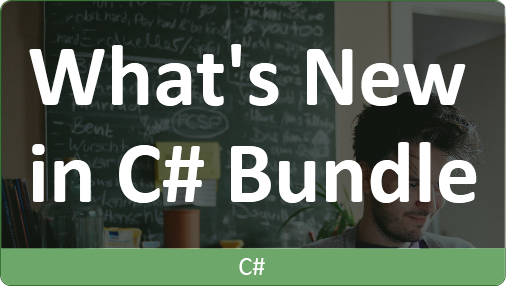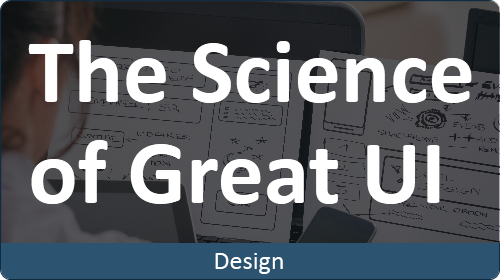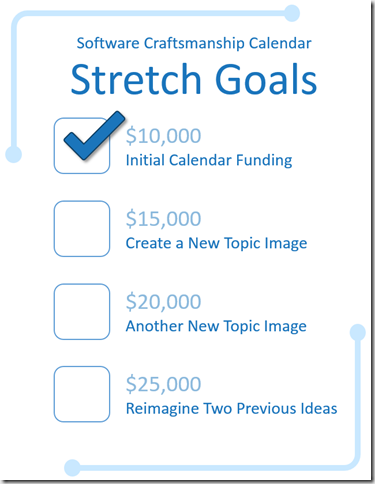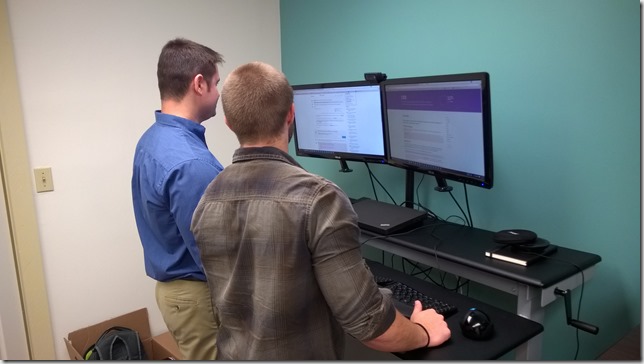Yesterday, I was working with my dev team, and some people came across some C# 7 code. Specifically, they were seeing some code using Pattern Matching, and weren’t sure about it. Not everyone was familiar with C# 7, a failing on my part. If you’re also not familiar with all of the new features in C# 7, I’d recommend checking out my What’s New in C# 7 course on DevIQ. In the course, I go through all of the new features of C# 7, explaining both how they work and when to use them.
I talk regularly at conferences about C#, and have given talks on C# 6, C# 7, and the combination of the two. When I ask people if they’re using a version of C#, most people acknowledge they are, but when I ask about specific features, most hands drop. I find that many developers are not using the features made available to them until long after it’s available to them. Don’t miss out on these!
As C# grows it’s important to stay up-to-date on everything that it offers you! Check out my course today and get your quick-start to using the new features in C# 7!
What You Will Learn About C# 7
In this course, you will learn:
- Output Variables
- Pattern Matching
- Local Functions
- Improved Literals
- More Expression Bodies
- Throw Expressions
- Tuples
- Ref Returns

What’s New in C# Bundle
And many developers need to know about C# 6 still. I did a course covering C# 6 as well, so you can check out the bundle I set up. The What’s New in C# Bundle includes both What’s New in C# 6 and What’s New in C# 7! Allowing you to learn everything you need to know to bring your C# project up-to-date!

Not a day goes by when I can avoid thinking about UI and UX. Sometimes, I’m thinking about real-world scenarios, but as a developer, I also have to consider it in the applications that I build. As developers, we really cannot avoid it, even when there’s someone else in charge of the UI/UX of the application we’re building. Thanks to Mark Miller’s DevIQ course, The Science of Great UI, I’ve been able to learn a lot more about UI and UX. It’s an in-depth course which really does focus on the science behind building good user interfaces. It’s not just a prescriptive, do X, Y, Z in this certain scenario, the course explains the science that’s dictating what makes a user interface good or bad. I learned a ton from this course!
As some of you may know, a few close friends of mine and I created a training company called DevIQ. We’re all passionate about technology and improving how people learn; we’re frequent speakers at conferences, run training workshops, and mentor other technology experts. As we create new courses, we’ll be posting them to DevIQ.com, so be on the lookout for more great courses all the time!
So once you’ve watched this course, you’ll be in the same boat that I’m in, waiting for Mark to produce the follow-up course Design Like a Pro. He’s doing a series of courses on design that will help you and me become better at designing great user interfaces.
Table of Contents
- Introduction
- Converting Light Into Understanding
- Certainty, Ambiguity, Context
- Grouping
- Symbols
- Cognitive Load
- Granularity
- Visual Search
- Background and Foreground
- Information Relevance and Emphasis
- Noise, Weak Signal, and Clarity
- Recognition vs. Recall, Orienteering, and Paths
- Responsiveness & The Feedback Loop
- Discoverability
- Efficiency in Thought & Motion
</ul> Go check out Mark’s course, The Science of Great UI!

If you’re looking to improve your C# 6 code by taking advantage of the new features added into the language, I’ve got you covered. By using C# 6, you’ll be able to clean up your code, and make things more concise. This was one of the focuses in the design of C# 6. You can clean up and remove the clutter from your projects by taking advantage of C# 6. My C# 6 course on DevIQ will show you how to use these new features to improve the code you’re writing today. You already have the tools and capability, and now you can learn how to take advantage of it!
As a consultant, I’ve worked with developers in different companies, and I find that most organizations are barely using the features of C# 5 let alone using C# 6. When I talk at conferences, most people say they’re using C# 6, and they technically are using it. Their code is compiled using C# 6, but they’re not using all of the features or know how powerful they can be!
To help teams with this, I created a quick-start, What’s New in C# 6 course on DevIQ that will help you get started using C# 6!
What You Will Learn
In the course, you will learn about:
- Property and Method Improvements
- String Improvements
- In-Line Code Improvements
- Exception Improvements
</ul>

After creating software craftsmanship calendars for four years, we (the software craftsmanship calendar team) took one year off. All we heard through December of 2014 and January of 2015 was people asking us how to get their 2015 calendar! Well, there wasn’t one! Unfortunately, none of us worked together anymore, so making the calendar became quite the challenge. There was no longer an employer backing all of us and fronting the bill for design costs and printing costs.
We found our solution to the problem though, we set up a Kickstarter to fund the initial costs of the 2016 calendar, and with the support of all of the backers of that campaign, we were able to create the 2016 software craftsmanship calendar.
What are these calendars?
The Software Craftsmanship Calendars use the motivational poster-style formatting with an image of a humorous real-world interpretation of a concept related to software development. These images and jokes throughout the calendar acts as entertaining reminders of the standards we all want to hold ourselves to.

With the 4th and 5th calendars, we discussed the idea of doing a “Greatest Hits” calendar where we would mostly use our best ideas from previous calendars. Some we would re-shoot the pictures, others might get touched up, and a few images would be new. This would make the it one of the best calendars we could make, since it was using our previous, great ideas! With five calendars under our belts, we’ve decided it’s time to do just that. We’ve got loads of previous images and ideas to choose from.
2017 Kickstarter
We’ve set up another Kickstarter. This time, for the 2017 Software Craftsmanship calendar.
Stretch Goals
We want most of the images in this calendar to be the best images from previous years, so that this calendar can be our best one yet. We are willing to take some chances by adding a couple of new ideas and images, so we’re setting those up as stretch goals this year.

Please go back our Software Craftsmanship 2017 Calendar Kickstarter, and get yourself or your team some calendars to remind you how you want to be building software. Or if you like, pick some up for those people who could really use the reminding.
I’m not exactly silent in my belief that pair programming will help our industry, so it should come as no surprise that Steve Smith and I paired together on a Pluralsight course on Pair Programming. It only made sense to me that a course on pair programming would be created by two people. We shared the work on each module of the course, and we think it turned out well.
In the course, we cover the theory, practice, benefits, technique, and research of pair programming. From this, we’re trying to make sure that people both know how to pair program effectively and know why it could benefit their team. If you or someone you know has heard of pair programming, I’d recommend watching the course.
Given the choice of typing twice as fast or thinking twice as fast, I know I would choose the latter every time. That’s why I always choose to pair program when someone is available to. We accomplish far more together than we do separately. You’ll learn how and why when you watch Pair Programming.







